#aspects in astrology
Text
Aspect Associations 1



Venus sextile Mars: The aspect of extreme charm
Venus rules over charm/attraction and Mars rules over lust/flirting. It can indicate someone has a way with words and is very good at flirting. Sextile’s are also harmonious aspects that can be associated sometimes with sexual energy, enhancing the effect of this aspect
Example: Jack Harlow
Pluto sextile Midheaven: The aspect of worldwide fame
Pluto represents areas where we have a lot of power and the Midheaven rules over career, public image, and fame. Sextile’s open pathways for areas of growth, so their fame just continuously grows, sometimes even after death
Example: Elvis Presley
Venus trine Jupiter: The aspect of easy wealth
Venus represents attraction and Jupiter represents success/wealth. Trines represent talents as well as things coming at ease and are a harmonious aspect. With this aspect you can attract lots of wealth with minimal effort
Example: Mark Zuckerberg
Venus trine Neptune: The aspect of extreme musical talent
Venus rules over harmonies (not just harmony in general), Neptune rules over music, and Trines represent our talents/things that come at ease. People with this aspect have natural talents involving music
Example: Ariana Grande
Mercury square Jupiter: The aspect of underestimated intelligence
Mercury represents the mind/intellect and Jupiter represents knowledge/wisdom. When these two aspect each other it indicate extreme intelligence. However, if they square each other because squares are challenging aspects, it can cause people to have a false perception of your intelligence
Example: Marilyn Monroe
Jupiter trine Chiron: The aspect of dark humor
Jupiter represents humor and Chiron represents karmic wounds. Often people with this aspect joke about their trauma due to this. The Trine makes them have naturally humorous dark jokes
Example: Theo Von
Mars square Pluto: The aspect of ops
Mars represents conflict/aggression, one of things Pluto represents is toxicity, and squares indicate challenges. Often people with this placement regardless if they’re someone who’s toxic or not will attract lots of ops (enemies)
Example: Nicki Minaj
These aspects are most relevant when under an orb of 4°

MY MASTERLIST - EXCLUSIVE CONTENT - READINGS

© 𝐚𝐬𝐭𝐫𝐨𝐬𝐤𝐲 𝟐𝟎𝟐𝟑 𝐚𝐥𝐥 𝐫𝐢𝐠𝐡𝐭𝐬 𝐫𝐞𝐬𝐞𝐫𝐯𝐞𝐝
#aspects in astrology#aspects#astrology aspects#astro community#astrology#zodiac#astro placements#astrology tumblr#astro chart#birth chart#aspect associations#venus sextile mars#pluto sextile Midheaven#venus trine jupiter#venus trine neptune#mercury square jupiter#jupiter trine chiron#mars square pluto
783 notes
·
View notes
Text
MASTERLIST
SUN ☉
MOON ☽
MERCURY ☿
VENUS ♀
MARS ♂
JUPITER ♃
SATURN ♄
URANUS ♅
NEPTUNE ♆
PLUTO ♇
OBSERVATIONS PART ONE
OBSERVATIONS PART TWO
OBSERVATIONS PART THREE
OBSERVATIONS PART FOUR
OBSERVATIONS PART FIVE
OBSERVATIONS PART SIX
OBSERVATIONS PART SEVEN
OBSERVATIONS PART EIGHT
MY FAVORITE SYNASTRY ASPECTS
MY LEAST FAVORITE SYNASTRY ASPECTS
SYNASTRY OBSERVATIONS PART ONE
SYNASTRY OBSERVATIONS PART TWO
SYNASTRY OBSERVATIONS PART THREE
FATED RELATIONSHIPS
LOVE & SEX; ASTRO OBSERVATIONS
STYLE & AESTHETICS; ASTRO OBSERVATIONS
THE NATAL CHARTS RELATION TO PHYSICAL APPERANCE
BEAUTY INDICATORS WITHIN ASTROLOGY
HAVING THE SAME SUN AND RISING SIGN
HAVING THE SAME SUN AND MOON SIGN
HAVING THE SAME VENUS AND JUPITER SIGN
LUNAR PHASES
THE 22ND DEGREE
ANNUAL PROFECTION YEARS
THE SIGNIFICANCE OF TIME LORDS
TIME LORDS AND THEIR RELATIONSHIP TO PROFECTION YEARS
CANT RELATE TO AN ASTROLOGICAL PLACEMENT?
HOW TO FIND YOUR DOMINATE PLANET
SCORPIO STEREOTYPES AND WHY THEY BETTER SUIT GEMINIS
PLUTO AND HOW IT RESPONDS TO OTHER PLANETARY ENERGIES
PLACEMENTS THAT CAN WIN A DEBATE
SOLAR RETURN OBSERVATIONS PART ONE
SOLAR RETURN OBSERVATIONS PART TWO
SOLAR RETURN OBSERVATIONS PART THREE
HOW TO FIND JOY USING YOUR SUN PLACEMENT
POETRY FOR YOUR MOON SIGN
THE PLUTO IN SAGITTARIUS GENERATION
TOTAL SOLAR ECLIPSE IN ARIES
ASTROLOGY MEMES
3K notes
·
View notes
Text
Aspects in Astrology (Astro lesson) ☌ ⚹ △ □ ☍ ⚻ ⚺
It's important to note that the practical meaning of an aspect can be highly individualized and specific to each person's natal chart. The overall impact and significance will depend on the context of the entire chart and how the planets interact with other aspects and placements.
CONJUNCTION (0º)
In astrology, a conjunction aspect is when two planets are in close proximity to each other in the same sign or very close in degree within the same sign. This aspect is considered one of the most potent and influential in a natal chart because it signifies a blending or merging of the energies of the planets involved. The practical meaning of a conjunction aspect can vary depending on the planets involved and the specific signs and houses they occupy, but here are some general principles:
Intensification of Energies: A conjunction intensifies the energies of the planets involved. It combines and amplifies their qualities, making them more prominent in the individual's personality and life experiences.
Unity of Energies: Planets in conjunction work closely together, often functioning as a unified force rather than separate influences. This can result in a strong emphasis on the combined qualities of the planets.
Focal Point: The planets in conjunction become a focal point in the individual's chart, drawing attention to specific areas of life or personality traits associated with those planets.
Blending of Characteristics: The characteristics of the planets involved are blended, creating a unique and distinctive personality trait or area of focus. For example, a Sun-Mercury conjunction may indicate strong communication skills and a sharp intellect.
Intensity of Expression: Individuals with conjunction aspects tend to express the combined qualities of the planets in a more direct and intense manner. This can lead to both strengths and challenges associated with those qualities.
Versatility: Conjunctions can make individuals versatile in the area represented by the planets involved. They may have the ability to switch between or integrate the qualities of the planets seamlessly.
Challenges and Opportunities: Conjunctions can bring both challenges and opportunities. The exact nature of these depends on the specific planets, signs, and houses involved. For example, a Venus-Mars conjunction may signify strong passions and desires in relationships, leading to both passionate love affairs and potential conflicts ("natural opposite planets"). The same goes to Moon-Saturn.
Personal Growth: Individuals with conjunctions often experience significant personal growth and self-discovery as they learn to balance and harmonize the energies of the planets in conjunction. This can be a lifelong journey of self-integration.
OPPOSITION (180º)
In astrology, an opposition aspect is when two planets are approximately 180 degrees apart from each other in the natal chart. This aspect is often seen as a significant aspect that highlights a dynamic tension or polarity between the energies of the planets involved. The practical meaning of an opposition aspect can vary depending on the specific planets involved and the signs and houses they occupy. Opposition general meanings:
Balancing Act: An opposition creates a sense of balance or opposition between the planets involved. It represents a push and pull dynamic, where the energies of the planets may seem to be in conflict or opposition to each other.
Awareness of Contradictions: Oppositions bring to light contradictions and opposing needs within an individual's personality or life circumstances. They often indicate areas of life where the individual may feel torn between two opposing forces or desires.
External Reflection: Oppositions can manifest as external events or people in the individual's life that mirror the internal conflict represented by the planets in opposition. This can lead to experiences that force the individual to address and reconcile these contradictions.
Resolution and Integration: While oppositions can represent challenges and conflicts, they also offer opportunities for growth and integration. Individuals with opposition aspects often develop the ability to find a middle ground and harmonize the opposing energies over time.
Full Circle: Some astrologers view oppositions as an aspect that encourages the individual to come full circle and find a way to integrate both sides of the opposition. It's like a journey of finding a balance point between the two opposing forces.
Strengths and Challenges: Oppositions can bring both strengths and challenges. The strengths come from the potential for growth and self-awareness that arises from resolving the tension. Challenges may arise from the initial conflict and the need to navigate opposing desires and needs.
Awareness and Choice: Opposition aspects often highlight areas where the individual must become aware of the opposing forces at play and make conscious choices about how to navigate them. This can lead to increased self-awareness and personal development.
Attraction-tension (Relationship Dynamics): In synastry (the astrology of relationships), oppositions between two individuals' planets can indicate both attraction and tension in the relationship. The planets involved may represent areas where the partners have opposing needs or desires.
SQUARE (90º)
In astrology, a square aspect is formed when two planets are approximately 90 degrees apart from each other in the birth chart. This aspect is considered challenging and dynamic, and it often signifies a source of tension, conflict, and growth in an individual's life.
Conflict and Challenges: Squares represent a conflict or challenge between the energies of the planets involved. This conflict can manifest as inner tension, external obstacles, or both.
Inner Motivation: Despite the difficulties associated with squares, they also provide a strong inner motivation to overcome obstacles and achieve goals. Individuals with square aspects often possess a driving force to resolve the tension.
Growth and Development: Squares are often seen as aspects of growth and development. They push individuals out of their comfort zones and encourage personal evolution and self-improvement.
Action and Initiative: Individuals with square aspects tend to take action to confront and resolve the challenges represented by the planets in square. This can lead to increased drive and determination.
Areas of Life: The practical meaning of a square aspect can be specific to the areas of life represented by the planets involved. For example, a Sun square Moon may indicate inner conflicts related to self-expression and emotional needs.
Problem-Solving: Square aspects encourage problem-solving and creativity in finding solutions to the conflicts and challenges they present. These aspects can lead to innovative thinking and new approaches.
Frustration: While squares can be motivating, they can also bring frustration and a sense of struggle. The difficulties associated with squares can be a source of stress until they are addressed and resolved.
Tension in Relationships: In synastry (the astrology of relationships), squares between two individuals' planets can indicate areas of tension and conflict in the relationship. These areas may require effort and compromise to harmonize.
Overcoming Limitations: Squares often symbolize limitations or obstacles that need to be overcome. They encourage individuals to confront their limitations and find ways to transcend them.
Balance and Integration: Ultimately, the practical meaning of a square aspect involves finding a balance and integration between the conflicting energies. This process can lead to personal growth, increased self-awareness, and greater resilience.
SEXTILE (60º)
In astrology, a sextile aspect is formed when two planets are approximately 60 degrees apart from each other in the birth chart. Sextile aspects are generally considered harmonious and favorable, and they represent opportunities for ease, cooperation, and positive growth.
Opportunities: Sextiles symbolize opportunities and potential benefits. They indicate areas of life where things may flow more smoothly and where individuals have a natural aptitude or talent.
Ease of Communication: Planets in sextile tend to communicate and work together effortlessly. This can lead to effective communication, cooperation, and collaboration between the energies represented by the planets.
Creativity and Innovation: Sextiles often inspire creativity and innovation. They encourage individuals to explore new ideas, take initiatives, and express their talents and abilities.
Positive Growth: Individuals with sextile aspects often experience personal growth and self-improvement in the areas represented by the planets involved. This growth tends to occur more easily and with less resistance.
Resourcefulness: Sextiles can indicate resourcefulness and the ability to make the most of opportunities. Individuals may have a knack for finding solutions to problems and making the most of their circumstances.
Balanced Expression: Sextiles promote balanced expression of the qualities associated with the planets involved. This balance allows individuals to harness their potential more effectively.
Supportive Relationships: In synastry (the astrology of relationships), sextiles between two individuals' planets suggest mutual support and compatibility in the areas represented by the sextiled planets.
Natural Talents: Sextile aspects often point to natural talents and abilities that individuals can tap into with relative ease. These talents can be further developed and honed.
Positive Energy Flow: There is a positive and constructive energy flow between the planets in sextile. This energy flow can be harnessed to achieve goals and make progress in various life areas.
Learning and Growth: While sextiles are generally considered easy aspects, they still offer opportunities for personal growth and development. They encourage individuals to maximize their potential.
TRINE (120º)
In astrology, a trine aspect is formed when two planets are approximately 120 degrees apart from each other in the birth chart. Trine aspects are considered highly harmonious and beneficial, representing natural talents, ease, and positive flow of energy between the planets involved. The practical meaning of a trine aspect can vary depending on the specific planets involved and the signs and houses they occupy, but here are some general principles:
Natural Harmony: Trines symbolize a natural harmony and compatibility between the energies of the planets. They suggest that the qualities represented by the trine planets work well together and complement each other effortlessly.
Talent and Abilities: Trine aspects often indicate innate talents, abilities, and gifts in the areas represented by the planets involved. These talents may come naturally and be expressed with ease.
Positive Flow: There is a positive and smooth flow of energy between the planets in trine. This flow can lead to favorable outcomes, cooperation, and success in the areas represented by the trine.
Creativity and Inspiration: Trines are associated with creativity and inspiration. They encourage individuals to tap into their creative potential and find innovative solutions to challenges.
Personal Growth: Trines can represent opportunities for personal growth and self-improvement. They provide a sense of ease and support in the pursuit of personal goals and aspirations.
Positive Relationships: In synastry (the astrology of relationships), trines between two individuals' planets suggest a high degree of compatibility, mutual understanding, and support in the areas represented by the trine.
Ease of Communication: Trine aspects often indicate ease of communication and cooperation. Individuals with trines may find it effortless to express their ideas and work collaboratively with others.
Harmonious Energy Exchange: Trines promote a harmonious exchange of energies between the planets involved, allowing individuals to harness these energies more effectively.
Abundance and Opportunities: Trines are associated with abundance and opportunities. They may signify favorable circumstances and a sense of abundance in the areas represented by the trine.
Positive Life Events: Trines can be associated with positive life events, such as achievements, fortunate circumstances, and moments of ease and enjoyment.
SEMI-SEXTILE (30º)
In astrology, a semi-sextile aspect is formed when two planets are approximately 30 degrees apart from each other in the natal chart. The semi-sextile is considered a minor aspect, and its influence is generally subtle compared to major aspects like conjunctions, squares, trines, and oppositions.
Mild Influence: The influence of a semi-sextile aspect is relatively mild compared to major aspects. It may not be as immediately noticeable in a person's life or personality.
Subtle Harmony: Semi-sextiles represent a subtle sense of harmony or connection between the energies of the planets. There is a hint of cooperation and integration, but it may not be as pronounced as in trine aspects.
Adjustment and Integration: Semi-sextile aspects often indicate areas where individuals need to make minor adjustments or integrate complementary qualities to harmonize conflicting energies.
Awareness: These aspects can bring awareness to the subtle nuances and interplay between the planets involved. Individuals may become more conscious of how these energies interact in their lives.
Potential for Growth: Semi-sextiles can represent opportunities for personal growth through the integration of contrasting qualities. They encourage individuals to find ways to work together and reconcile differences.
Balancing Act: There may be a sense of balance and adjustment required in the areas of life represented by the planets in semi-sextile. This aspect can highlight the need for compromise and adaptability.
Attention to Detail: Semi-sextiles may indicate a need to pay attention to small details or make minor changes in specific life areas to improve overall well-being and effectiveness.
Incremental Progress: Individuals with semi-sextile aspects may experience gradual, incremental progress in the areas represented by the planets involved. It may take time to see significant changes.
Relationship Dynamics: In synastry (the astrology of relationships), semi-sextile aspects between two individuals' planets suggest a subtle sense of understanding and cooperation in the areas represented by the semi-sextiled planets.
Supportive Energies: Semi-sextiles can provide a mild sense of support and encouragement in the areas represented by the planets, even if the influence is not as overt as in trines or other major aspects.
QUINCUNX / INCONJUNCT (150º)
In astrology, a quincunx aspect is formed when two planets are approximately 150 degrees apart from each other in the birth chart. The quincunx, also known as an inconjunct aspect, is considered a minor aspect, and its influence can be complex and somewhat challenging to understand. The practical meaning of a quincunx aspect involves a sense of adjustment, adaptation, and integration between the energies of the planets involved.
Adjustment and Discomfort: Quincunx aspects often indicate areas of life where individuals need to make adjustments or adapt to seemingly incompatible energies represented by the planets. This adjustment can feel uncomfortable or unfamiliar.
Incongruent Energies: The planets in quincunx typically represent energies that don't naturally blend or work together. This can create a sense of tension or imbalance in the areas of life associated with these planets.
Problem-Solving: Quincunx aspects encourage problem-solving and finding creative solutions to reconcile the conflicting energies. Individuals may need to be flexible and open to experimentation.
Awareness and Growth: Quincunxes bring awareness to the nuances and contradictions in life areas represented by the planets involved. This heightened awareness can lead to personal growth and self-improvement.
Continuous Adjustment: Individuals with quincunx aspects may feel like they're in a continuous process of adjustment and fine-tuning in the areas represented by the planets. It may take time to find a balance.
Health and Well-Being: In some cases, quincunx aspects can be associated with health-related issues, as they may indicate the need to make adjustments in lifestyle or habits to maintain well-being.
Relationship Dynamics: In synastry (the astrology of relationships), quincunx aspects between two individuals' planets suggest areas of adjustment and adaptation in the relationship. These areas may require effort and compromise.
Potential for Growth: While quincunxes can be challenging, they also offer opportunities for personal growth through the integration of contrasting qualities. The process of adjustment can lead to greater understanding and maturity.
Subtle but Persistent: Quincunx aspects are often subtle but persistent in their influence. They may not be as overt as squares or oppositions but can still be significant over time.
Progressive Changes: Individuals with quincunx aspects may experience progressive changes and improvements as they navigate the challenges presented by the planets in quincunx.
196 notes
·
View notes
Text
Harmonious vs Harsh aspects in a birth chart:

🌸 Harmonious Aspects: 🌸
Conjunction (0°)
Trines (120°)
Sextiles (Which i actually I found out that they are rare aspects to have in a chart after a whole night of searching) (40°)
Quintile (Q)
Bi - Quintiles
🌸 Neutral aspects 🌸
semi - sextiles
semi - sqaures
🌸 Harsh aspects: 🌸
Conjunction (0°)
Square (90°)
Opposition (180°)
🌸: Why is conjunct both harsh and harmonious? Well it depends on the conjuncting placements because not all planets get along with eachother
🌸🌸🌸🌸🌸🌸🌸🌸🌸🌸🌸🌸🌸🌸🌸🌸🌸🌸
- Harmoonix 🌸
#astrology#astro observations#birth chart#astro fyp#astrology fyp#astrology observations#astro notes#placements#astro community#horoscope#zodiac#aspects in astrology#harsh aspects#harmonious aspects#good aspects#conjunction
220 notes
·
View notes
Text
Aspects in Astrology Explained - Part 2:
Minor Aspects


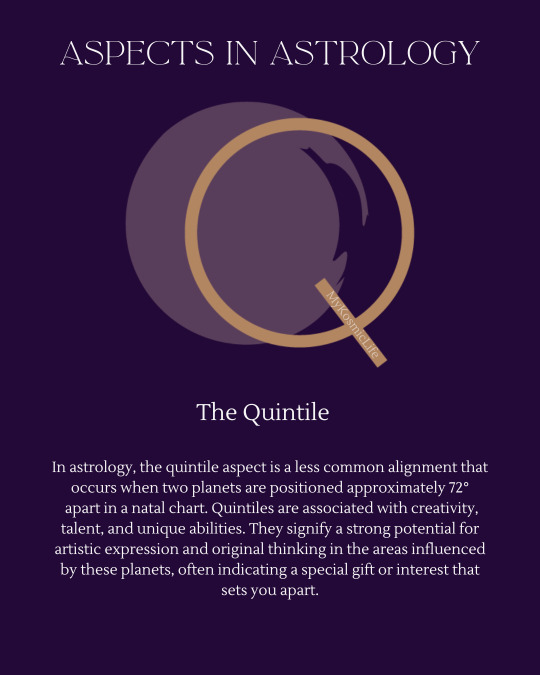
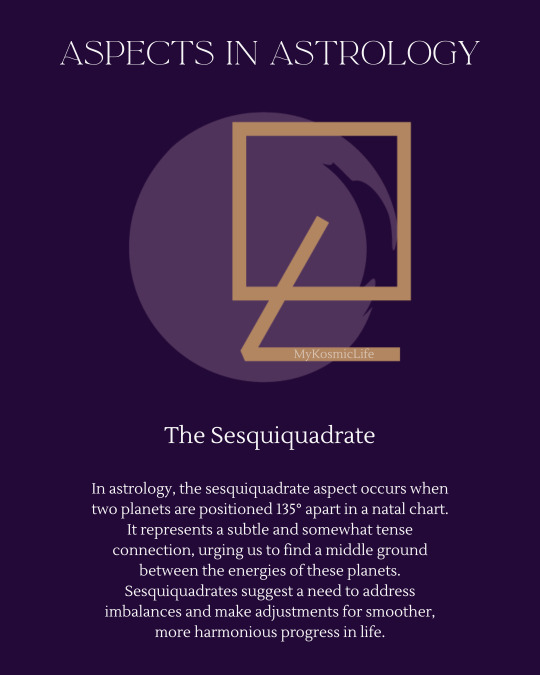
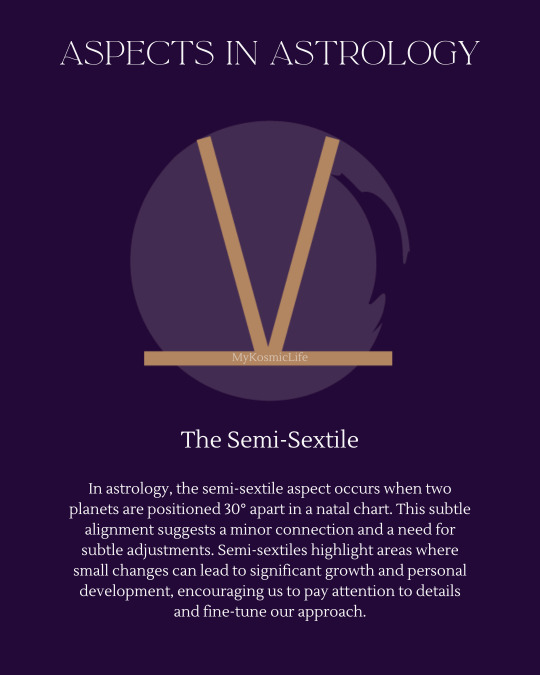

#aspects in astrology#astrology aspects#minor aspects#Minor aspects in Astrology#Inconjunct#Semi-sextile#Quintile#Semi-square#Sesquiquadrate#Bi-quintilr#Bi-quintile#sokosmic#mykosmiclife#astrology#astrologist#Astrologer
126 notes
·
View notes
Text
Aspects in Vedic Astrology
A planet is said to be mutually aspecting another planet when it is either situated in the same sign/house or seven signs/houses apart.
In addition to aspecting a planet seven houses away, Mars, Jupiter, and Saturn each have special aspects.
Mars always aspects the 4th and 8th houses from it
Jupiter aspects the 5th and 9th
Saturn aspects the 3rd and 10th.
In addition to one planet aspecting another, a planet always aspects a house even if it is unoccupied.
It is important to remember that while aspects are considered most exact when they share the same numerical degrees, they are formed according to the houses which the-planets occupy and not according to the degrees which lie between them.
#vedic astrology#vedic astro notes#astro community#astrology community#astrology#vedic astrology notes#astrology notes#astrology aspects#aspects in astrology#aspects in vedic astrology
94 notes
·
View notes
Text
Random Astro-observations part 2:
Venus-mars aspects natives are able to see and understand both the male and female POV.
Example: when a male or female friend tell me about their issues with the opposite sex, I give great advice because I understand both parties and what they’re thinking.
Mercury in the 8th can get you to spill your trauma and secrets but will def find a way to avoid speaking about theirs
A theory of mine: If you want to feel in your power then look to the house & sign your moon is placed. This is for internal. To feel good inside. Also degrees count!
Example my moon is in Leo in the first at 6 degrees.
I focus on my physical body/appearance and do what makes me feel good, healthy & beautiful. Eat healthy, work out, buy clothes that shape my body, do my hair, mani-pedi, focus on my self care, detox my body, and just put a huge emphasis on my overall health because it affects my entire body.
My confidence is shot up and the validation I seek is coming from within.
If you wanna add more and elevate your power then look to your sun! I’m a Pisces sun at 17 degrees in the 8th.
Showcasing my spiritual knowledge
Embracing my sexuality (in the most Leo way as possible haha)
Learning and reading on occult things. Studying astrology and reading charts and learning from people or teaching them.
Using my occult knowledge in order to embrace my sexuality (reading into the deities or doing beauty/sex magic)
I know moon square moon gets a bad rep in synastry (especially romantically) but I feel in friendships it’s easier. As long as both people are evolved and continue their growth. Me and my bestie have this and have known each for 15 years. COMMUNICATION IS OF THE UTMOST IMPORTANCE!!
Mercury in water signs are actually great listeners. Sometimes they don’t say much but trust me, they can hear the truth behind what you’re saying.
Pluto trine ascendant may be able to read others very well and their intentions but a Pluto square ascendant has a shield where people can’t read them at all ;)
Venus opposite moon is a difficult aspect to live with because you want open yourself to love and letting others love you but you’re so afraid to get hurt. Also differentiating between lust and love is the worst. You don’t even know yourself.
Jupiter trine mercury: you’re funny AF. Period. Like making people rolling in the floor crying and not breathing funny. You don’t say stupid stuff or do stupid things. You’re witty, sarcastic and your humor is beyond this world.
#astrology#astrology notes#astrology tumblr#zodiac signs#astro notes#astrology observations#natal astrology#zodiac#astro community#astro natal#astro observations#astrology101#astrology indications#astro#aspects in astrology#vedic astrology
849 notes
·
View notes
Text
𝔄𝔰𝔭𝔢𝔠𝔱𝔰 𝔦𝔫 𝔰𝔶𝔫𝔞𝔰𝔱𝔯𝔶

I wanted to make a quick post about synastry. I have specialised in synastry for three years now and wanted to write about some things up that I have seen floating around on the internet/ social media. I have seen some people saying how squares and oppositions in synastry automatically mean you won’t get along or that the relationship will be toxic. This is no the case. An important thing to remember is that there is no such thing as perfect synastry.
Squares and oppositions in synastry are important too. If there was only easy aspects and conjunctions it can be argued that the relationship would be too boring/ have no spark. Sometimes for a spark to be created things need to have friction, This is where squares and oppositions come in. When people are too similar there is a lack of tension. Things may flow but it will get mundane. Imagine someone constantly just agreeing with you. Differences between people make their interactions interesting.
This is not to say that trines and sextile aren’t important, of course they are. That natural flow and feelings of ease are what make the relationship feel soft and sweet. At the end of the day people in a relationship need to get along. When you have a trine or sextile between two planets they compliment each other and create harmony. However this once again doesn’t make hard aspects a bad thing.
Yes hard aspects can show where there can be tension as previously mentioned. And yes this can lead to disagreements sometimes. However this is also where sexual tension can be built. Now this does depend on which planets are selecting each other. In my opinion soft aspects show sweetness, however hard aspects can show passion and sometimes indicate where those stronger feelings come in, The ones that really get under your skin. You can see how both hard and soft aspects are needed to create a strong relationship/bond between two people.
So please, next time you are looking at a synastry chart, please don’t worry when you see squares and oppositions.
Also I am going to be writing more about synastry on here. If you would like a synastry reading from me please get in touch :)
Credit - Pureastrologywisdom
#synastry astrology#synastry#astrology blog#astro notes#astro observations#aspects in astrology#astrology#astroblr
183 notes
·
View notes
Note
I wanted to know about Moon conjunct lilith personality?🌙 how is this placement like?
Thank you for your patience<3
Moon conjunct Lilith

This placement shows someone who is gravitated towards the paranormal, vamipires , ghosts , someone who can connect to them easily , find representation of their feelings in paranormal creatures . It is a great placement for developing Intuition as well . Associated with manipulation as well (that doesn't mean it's always bad ). Alteration of others emotions or self emotions, like dark psychology.
You could have a lot of intrusive thoughts and hard time connecting to the true essence of you , because of your past maybe you were made fun of because of your emotions.
Your motherly figure might have given you a hard time or she was fiercely independent so it was hard like , you could have been scolded for crying or expressing emotions.
A developed moon - lilith shows someone who has complete control over their emotions because of their experiences, they can easily connect to others dark sides , shows a very strong figure , someone unshakable, a heartbreaker , a coquette .
163 notes
·
View notes
Text
ASPECTS IN ASTROLOGY

There are two ways through which planets influence one another, and those would be rulership and aspect. We dealt with rulership in yesterday's post regarding essential dignities. Now let's look into how aspects work.
Starting with a definition, aspects are geometrical configurations describing different types of dynamics between planets, and they are the main means through which planets communicate. The five major aspects, also known as the Ptolemaic aspects (though they predate Ptolemy), are the conjunction, opposition, trine, square, and sextile.
With that said, we can split them into two categories:
🔮 Harmonious: Sextile, Trine.
— They have the nature of benefic planets: Venus & Jupiter, respectively.
— Harmoniously aspected (trine, sextile) planets work well together and work to express their respective qualities cohesively. Harmony allows for the positive expression of each planet to be more present than the negative one.
🔮 Disharmonious: Square, Opposition.
— They possess the nature of malefic planets: Mars & Saturn, respectively.
— Disharmoniously aspected planets perform in discordance. They represent planets that can't work well together because they have different priorities, resulting in friction and discord.
→ aspects can be divided into two types, same-sign aspects, and those based on visual metaphors.
Category 1 :
🔮 CONJUNCTIONS:
Conjunctions are not regarded as aspects by many. They represent planets standing right next to each other, on the same degree (or within a small-ish orb of each other), in the same sign, and depending on each planet involved, this can be a positive or negative aspect. A common & incorrect misconception is that planetary energies are "mixed together" through conjunctions — what conjunctions actually describe is planets generally being on the same page & having the same objective. How they express this objective together will be filtered through the nature of each planet.
🔮 CO-PRESENCE :
In addition to conjunction, we can also list one additional configuration that, while not considered an aspect per se either, is still regarded as powerful: co-presence. Planets that are said to be copresent by sign without being conjoined by degree are said to be especially influential upon each other, owing to being “with” each other. However, it is not specifically called an aspect because the planets are literally in the same place, rather than “seeing” each other.
Category 2 :

The other four aspects are based on a visual metaphor that utilizes the thema mundi (which calls for a post of its own), but, tl;dr: the thema mundi is a mythical chart used in Hellenistic astrology that shows the alleged positions of the seven visible planets (including the Sun and Moon) at the beginning of the universe—its' main uses are to explain the logic behind the rulership system, provide meanings to the aspects, among other things. It's of purely symbolic nature.
🔮 Sextile — of the nature of Venus. Harmonious, mildly positive.
A sextile is when two planets are 60° apart from each other. These planets share polarity (diurnal vs. nocturnal), so they operate in the same way. The relationship is one of complement and harmony.
🔮 Trine — of the nature of Jupiter. Harmonious, very positive.
A trine is when two planets are 120° away from each other, sharing the same element but not modality (opposite of a Square). These planets can work very well together because they share the same element. The relationship is one of strong harmony much like the nature of Jupiter. Oftentimes trines tend to signify unconscious gifts & areas one is considered a "natural" at.
🔮 Square — of the nature of Mars. Disharmonious, combative, denotes friction.
Squares take place when planets are 90° apart from each other. These planets share the same modality (Cardinal, Fixed, or Mutable) but their expression (read: their element) of that modality is different, and that is what causes the friction. Mainly represent internal conflicts within the native.
🔮 Opposition - of the nature of Saturn. Very disharmonious, conflicted.
Planets within a 180° orb are said to oppose each other directly on the zodiac wheel. The planetary energies involved are actively working against each other. It denotes discord, standoffishness, or obstruction, much like the nature of Saturn.
🔮 Signs Not In Aspect :
Signs that are not in one of the above 4 relationships with each other are said to be “inconjunct” or “not in concord”.
→ Now that we went through the respective qualities of each aspect, let's explore another relevant topic — orbs & applying/separating aspects :
🔮 Orbs :
Represent the margin & range of influence in which the aspect between two planets is thought to come into effect & have a significant influence. Feel free to use whatever orbs feel comfortable for you, but know the wider the orb: the less of a connection these planets have, and the smaller the orb, the stronger the connection. Most astrological programs & sites use a default orb of 10°.
🔮 What about the dynamics of application & separation between planets?
If any planets are applying/separating in aspect: the faster planet makes the aspect, the slower planet receives the aspect. Which is to say: only faster-moving planets make aspects (applying or separating).
The order of speed has already been discussed in another post but a reminder that the order goes: Moon > Mercury > Venus > Sun > Mars > Jupiter > Saturn.
TL;DR : the Moon creates the most aspects (i.e can apply or separate from any planet, is always on the aspect-making end), while Saturn creates the least aspects (i.e it can only apply or separate from outers, is usually on the receiving end). You can deduce how it goes for other planets following this framework.
Applying aspects are granted a wider orb than separating ones in certain branches of astrology — because the energies are proactive, converging, and the climax is still approaching. Separating aspects, on the other hand, are reflective, as the aspect has passed the point at which it was exact, and are moving away from it.
Additionally, applying & separating aspects also have their own significations. In horary astrology, applying aspects can be used to predict upcoming events that will happen between individuals/areas of life, while separating aspects is used to describe past events.
So to summarize: when a faster planet is moving towards the exact degree of an aspect with a slower planet, that aspect is applying. Conversely, when a faster planet is departing from the exact degree of an aspect with a slower planet, that aspect is separating. Aspects become more intense as the applying planet gets closer, and they are particularly potent when within a 3° Orb. After separation, aspects become less intense. While a separating aspect lack the urgency of an applying aspect, it (especially when involving the Moon) is still essential for certain Hellenistic techniques like electional astrology, primary directions, or horary astrology.
28 notes
·
View notes
Text
📌Jupiter is about freedom. But supression of freedom is not Saturn as many people think, but sign in Opposition to Jupiter sign📌

Saturn doesn't supress our freedom. It shows us ethical ways to become more free. Saturn saves us from wrongdoings that can supress our freedom
A native with Jupiter in Conjuction to Saturn is very life-wise. He knows where he's not allowed to cross the board. His parents are very strict and conservative like Saturn
A native with Jupiter in Opposition to Saturn needs to be given lots of freedom to learn his own way to live life. He's very attached to his parents, but grows up at a very young age at the same time. He doesn't know any boundaries because his parents allow him to treat them how he wants to
#planets#jupiter#saturn#natal chart planets#aspects in astrology#aspects#jupiter aspects#saturn aspects#astro observations#astro notes#astrology
82 notes
·
View notes
Text
ASPECTS THAT CAN’T PHYSICALLY OCCUR IN NATAL CHARTS
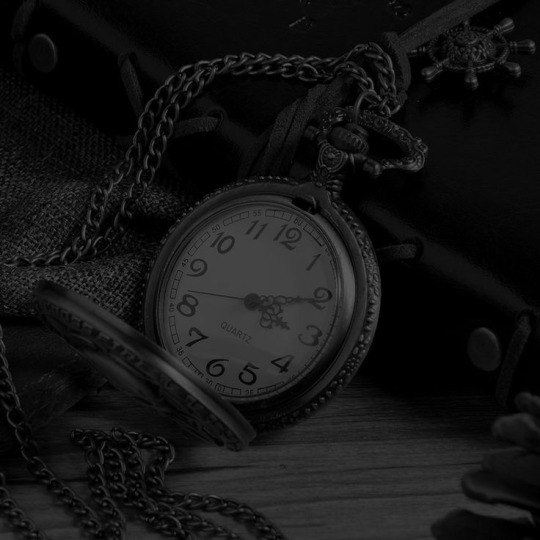
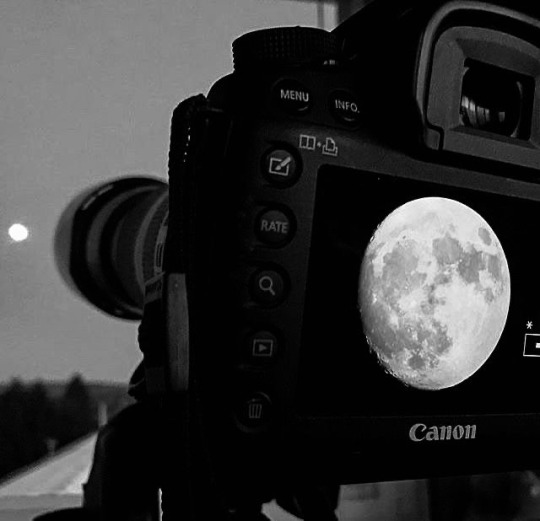

Mercury can only be the same sign as your Sun, the sign before it, or the sign after (within 28° of your Suns sign) and Venus can only be the same sign as your Sun, 1-2 signs before it, or 1-2 signs after it (within 48° of your Suns sign)

✘ Sun opposite Mercury
✘ Sun square Mercury
✘ Sun trine Mercury
✘ Sun sextile Mercury
✘ Sun opposite Venus
✘ Sun square Venus
✘ Sun trine Venus
✘ Mercury opposite Venus
✘ Mercury square Venus
✘ Mercury trine Venus

𝗠𝗔𝗦𝗧𝗘𝗥𝗟𝗜𝗦𝗧

© 𝐚𝐬𝐭𝐫𝐨𝐬𝐤𝐲 𝟐𝟎𝟐𝟑 𝐚𝐥𝐥 𝐫𝐢𝐠𝐡𝐭𝐬 𝐫𝐞𝐬𝐞𝐫𝐯𝐞𝐝
#aspects in astrology#astro community#astrology#zodiac#astro placements#astrology tumblr#astro chart#birth chart#aspects#planetary aspects#sun square mercury#sun opposite mercury#sun trine mercury#sun sextile mercury#sun trine venus#sun square venus#sun opposite venus#mercury square venus#mercury opposite venus#mercury trine venus
188 notes
·
View notes
Note
Hey, can you please do Sun Sextile Jupiter🙏🏻
SUN SEXTILE JUPITER

This is the aspect of a philosopher. People with this placement are wise and have a vast amount of knowledge in areas surrounding religion, politics, and worldly cultures. They champion for the social welfare of their community and often involve themselves within moral issues and conundrums. They care a lot and just want others to be happy. Although this placement brings about a certain amount of luck to the natives life, they still face many setbacks. Life can still be hard for these types, but this doesn’t stop them from finding the next best opportunity. These people find meaning in their life through many different avenues, they are chasing after inspiration.
#sun sextile Jupiter#astrology placements#astrology tumblr#birth chart#astro community#astrology#astro observations#astrology observations#aspects#astro notes#zodiac signs#natal astrology#astrology notes#astrology signs#aspect#natal aspects#aspects in astrology#sun aspects#Jupiter aspects#Aries sun#Taurus sun#gemini sun#cancer sun#Leo sun#virgo sun#libra sun#scorpion sun#sagittarius sun#Capricorn sun#Aquarius sun
194 notes
·
View notes
Text
Moon-Saturn aspects - differences 🌙🪐
(inner x external life; emotions x duties; vulnerability x closeness)


The aspects between the Moon and Saturn in an individual's natal chart reveal important information about their emotional nature, coping mechanisms, and relationship with authority, structure, and responsibility.
📍📖✏️ In many cases, Saturn's energy can appear dominant, especially early in life. This can result in individuals who are reserved, cautious, and serious. They may feel the weight of their responsibilities keenly and may struggle to express their emotions openly.
Today we'll talk about the practical differences between Moon conjunct, square, opposite, sextile and trine Saturn aspects:
In summary, the practical differences between Moon conjunct, square, opposite, sextile and trine Saturn aspects primarily revolve around the level of tension or harmony in integrating emotional needs and responsibilities. While some challenging aspects (square and opposite) may bring struggles and conflicts, harmonious aspects (trine and sextile) often signify a smoother integration, and the conjunction aspect tends to create a strong, focused approach to managing emotions and responsibilities.
Moon Conjunct Saturn:
This aspect can contribute to feelings of insecurity and self-doubt. Individuals may question their own worthiness and often feel a need to prove themselves to others or to authority figures.
This aspect can lead to emotional restraint and a fear of vulnerability. These individuals may have learned to suppress or control their emotions early in life.
They may lack self-compassion and be overly critical of themselves. Learning to be kinder to themselves is an essential part of personal growth.
These individuals may find it challenging to nurture and care for others emotionally, even if they desire to do so. Their own emotional struggles can make it difficult to provide emotional support.
There can be a deep-seated fear of rejection or abandonment. These individuals may guard their hearts closely to avoid getting hurt, which can make it challenging to form intimate relationships.
In some cases, this aspect can contribute to a tendency toward melancholy. The weight of responsibilities and emotional restraint can lead to periods of sadness and isolation.
Despite emotional challenges, they possess inner strength and resilience. They can handle adversity and setbacks with patience and determination.
Moon conjunct Saturn individuals tend to be highly resilient. They have the ability to endure difficult circumstances, setbacks, and emotional challenges without giving up easily. This resilience can serve them well in the face of adversity.
They have a strong sense of responsibility, both to themselves and to others. They take their commitments seriously and can be relied upon to fulfill their obligations and duties.
There is a sense of maturity and wisdom.
Moon conjunct Saturn individuals often learn valuable life lessons through their experiences with hardship and adversity. These lessons can lead to personal growth and resilience.
They may appreciate and value tradition, history, and the wisdom of the past. This can provide a sense of continuity and connection to their roots.
Moon Square Saturn:
Moon square Saturn individuals may experience tension between their emotional needs and the limitations or demands of the external world. This aspect can manifest as inner conflicts.
One of the primary challenges for Moon square Saturn individuals is learning to open up emotionally, express vulnerability, and overcome their fear of rejection. This often involves seeking therapy or counseling to address deep-seated emotional issues.
They may struggle with feelings of inadequacy and insecurity, particularly in emotional relationships. Fear of rejection or criticism can be common.
They may find it challenging to nurture and care for others emotionally, even if they desire to do so. Their own emotional struggles can make it difficult to provide emotional support.
Early experiences with their parents or caregivers may have a significant impact on their emotional development. They may have experienced strict or critical parenting, which can leave lasting emotional scars.
There is often a deep-seated fear of rejection or abandonment. This fear can lead to a reluctance to open up emotionally, making it challenging to form and maintain close relationships.
Developing self-confidence and self-compassion is essential. They must learn to love and accept themselves as they are, recognizing that they are deserving of love and support.
Balancing responsibilities and emotional needs can be another challenge. They may need to find a way to meet their obligations without neglecting their own emotional well-being.
Over time, unresolved emotional issues can lead to feelings of resentment and isolation. They may struggle to connect with others on a deep emotional level, leading to a sense of loneliness.
They often have a strong work ethic and may channel their emotional energy into their careers or responsibilities. They find a sense of security through achievement.
Overcoming the challenges of this aspect can lead to personal growth and increased emotional resilience. Learning to balance emotions and responsibilities is one of the key lessons.
They are seen as reliable and dependable by those who know them well. They can be counted on to fulfill their commitments and responsibilities.
Moon Opposite Saturn:
The main manifestation of the Moon opposition Saturn is the difficulty in attending to both sides; it seems like there's an internal tug of war. This is because there's a significant conflict in the language they speak. One speaks in language X, the other in Y, and they are opposites.
However, as opposites, they also complement each other. That's why all the tension that manifests in the personality of this individual, involving the Moon and Saturn, emotions and obligations, emotions and responsibilities, exists to bring AWARENESS to the individual that they don't need to manifest just one side.
For example, Moon in Leo and Saturn in Aquarius. The person with Moon in Leo has a dynamic, open, expressive, and creative nature, while Saturn in Aquarius limits experiences, reminding the importance of responsibility and awareness in exchanges, relationships, especially in groups and friendships. Leo and Aquarius speak completely different languages, so we have an opposition manifesting here.
The opposition will bring difficulties because at times the individual will want to follow the desires of Moon in Leo, and at other times, those of Saturn in Aquarius. There will be difficulty in attending to both sides. However, what we need here is balance and complementation. These are placements that complement each other and will play their own part at the right time as the individual develops their AWARENESS.
Awareness of the importance of both sides existing. Awareness of the usefulness of both. Awareness that both sides are part of them. Awareness of when to use, when to complement.
Therefore, it's an aspect of constant difficulty: emotions versus practicality, inner world versus outer world, flow versus restriction, expressions versus reclusiveness. The individual will feel the imbalances until they can manifest both sides with balance. And that's the learning process of an opposition aspect.
Moon opposite Saturn individuals often face external challenges related to their emotional needs versus their responsibilities. These challenges may manifest in relationships or career choices.
They seek balance between their emotional life and their practical duties. This aspect encourages them to find ways to meet their emotional needs while fulfilling their obligations.
Moon opposite Saturn can create challenges in personal relationships, especially with regard to emotional expression and vulnerability. These individuals may attract partners who mirror the Saturnian qualities, leading to complex dynamics.
Moon opposite Saturn individuals may become workaholics, using their responsibilities and work as a way to avoid dealing with their emotions.
They may have difficulty expressing their emotions openly and may tend to suppress their feelings, especially in public or formal settings.
They may seek external validation and approval as a way to compensate for inner insecurities and doubts.
Internally, there can be a constant internal conflict between the desire for emotional fulfillment and the fear of the consequences of emotional expression. This inner tension can lead to mood swings and periods of emotional repression.
Over time, they can develop emotional resilience and the ability to handle adversity with composure and patience.
Moon Sextile Saturn:
Moon sextile Saturn individuals have a harmonious integration of their emotional needs and responsibilities. They can balance their feelings and practical duties effectively.
They often have emotional stability and a strong sense of self-discipline. They can manage their emotions without suppressing them.
These individuals tend to be self-reliant and independent. They may have a solid foundation of self-confidence and self-worth.
The sextile aspect facilitates constructive achievement and personal growth. They can work toward their goals and responsibilities without feeling overwhelmed.
Moon sextile Saturn individuals tend to have a stable and controlled emotional nature. They are less prone to emotional extremes and can handle difficult emotions with maturity and composure.
They take their responsibilities seriously and are known for their reliability and commitment. They often have a strong work ethic and a sense of duty.
These individuals excel in structuring their lives and maintaining a sense of order. They appreciate routines and organization, which can lead to greater stability.
Moon sextile Saturn fosters emotional resilience, allowing individuals to bounce back from setbacks and challenges. They can handle adversity with grace and determination.
They are adept at making practical and well-thought-out decisions, especially when it comes to matters related to their emotional well-being and personal security.
Moon sextile Saturn individuals often think in the long term. They set realistic goals and are willing to work patiently and steadily toward achieving them.
This aspect promotes a balanced expression of emotions. They can communicate their feelings in a controlled and constructive manner, which can be beneficial in personal and professional relationships.
Moon sextile Saturn individuals tend to display emotional maturity from a young age. They may have had to take on responsibilities early in life, which contributed to their emotional development.
They often have a strong sense of commitment to family and may take on caregiving roles or responsibilities within their family unit.
They are efficient and organized in their daily lives, which allows them to manage their time and resources effectively.
Moon sextile Saturn individuals have a drive to achieve their goals and ambitions. They are willing to put in the effort and discipline required to succeed.
They have a good balance of emotional sensitivity and the ability to establish healthy boundaries, which enables them to navigate relationships effectively.
Moon Trine Saturn:
The Moon trine Saturn aspect is considered a harmonious and positive aspect in astrology, indicating an easy flow of energy between the Moon (emotions and instincts) and Saturn (responsibility, discipline, and structure).
They possess emotional maturity, self-discipline, and a strong work ethic, making them well-equipped to navigate life's challenges and fulfill their goals and obligations. This aspect often reflects a stable and responsible approach to both personal and professional matters.
Individuals with the Moon trine Saturn aspect often possess emotional stability and self-discipline. They have a natural ability to manage their emotions in a balanced and constructive way.
They can assess situations with a clear and realistic perspective.
These individuals tend to be self-reliant and independent emotionally. They can provide for their own emotional needs without excessive reliance on others.
The Moon trine Saturn aspect suggests that emotions are channeled in a structured manner. They are less likely to be overwhelmed by emotional outbursts and can maintain composure during challenging times.
This aspect often reflects a strong sense of purpose and long-term goals. They are willing to put in the necessary effort and work hard to achieve their objectives.
In relationships, they are likely to take their commitments and responsibilities seriously. They are reliable and supportive partners, often providing stability in their relationships.
They excel at time management and can balance their emotional needs with their daily responsibilities efficiently.
Moon trine Saturn individuals have emotional resilience, which means they can bounce back from setbacks and difficulties with grace and determination.
There is a strong sense of duty and responsibility, especially toward family and loved ones. They prioritize their obligations and take care of those who depend on them.
They are good at long-term planning and tend to make decisions that have a lasting and positive impact on their lives.
#moon-saturn aspects#moon trine saturn#moon conjunct saturn#moon sextile saturn#moon opposite saturn#moon square saturn#moon saturn#aspects in astrology#aspects#astrology
312 notes
·
View notes
Text
In reference to the reblog of my recent post about Aspects in Astrology, it is important to remember that the combination of planets involved in the aspect (say here the Sun and Mars as an example) is more important than the type of aspect that they make.
Wait...what?
Yeah, you won't find this in a basic how-to astrology book and its such a shame.
The Sun + Mars in aspect with each other - no matter what aspect - will make the person more Martian as a whole, as if (at least to a certain point) they were an Aries. They will be more forceful and independent (than their Sun sign would normally be). They will likely have higher energy and possibly be prone to mania or other forms of energy overload. They may suffer from insomnia and other sleep conditions because they can't calm down enough at night to get a rest.
This is regardless of aspect.
The aspects tell us how easy or difficult the person will experience this collaboration of Sun+Mars energy. On average, trines and sextiles are experienced as easier aspects, squares and oppositions are experienced as more challenging aspects, and conjunctions can go either way depending on the planets involved.
So, to take our above example.
A person with Sun trine or sextile to Mars may enjoy the amount of energy that Mars lends to their sun - they might be a real go-getter. A person with Sun square or opposed to Mars may be endlessly aggravated by the lack of downtime that these energies provide. Sun conjunct Mars is generally considered to be a positive aspect in this scenario and would be like the trine or sextile but turned up to 11.
That said, aspects should NEVER be read alone or out of context with the rest of the chart. A square between Sun in Gemini and Mars in Virgo differs greatly from a square between Sun in Scorpio and Mars in Aquarius. The signs matter; some sun sign squares naturally work together better than others. Additionally, any other aspects with the Sun and Mars will also come into play here, as well as the houses that the planets fall into, and the overall feeling of the chart.
21 notes
·
View notes
Text
Aspects in Astrology Explained - Part 1:
Major Aspects

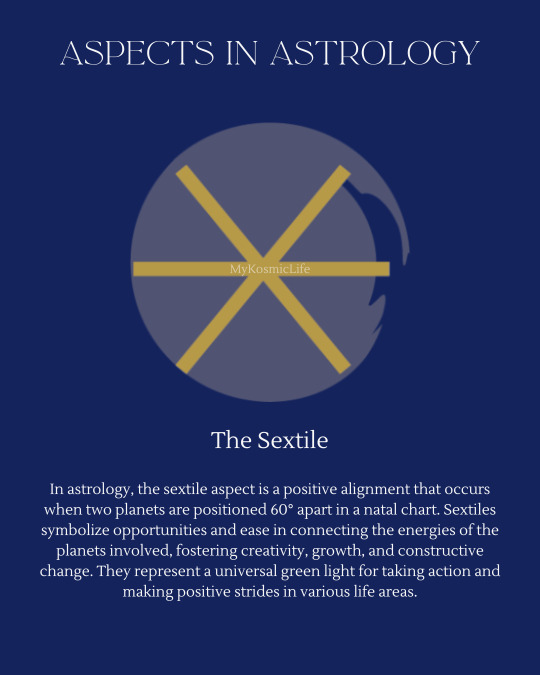
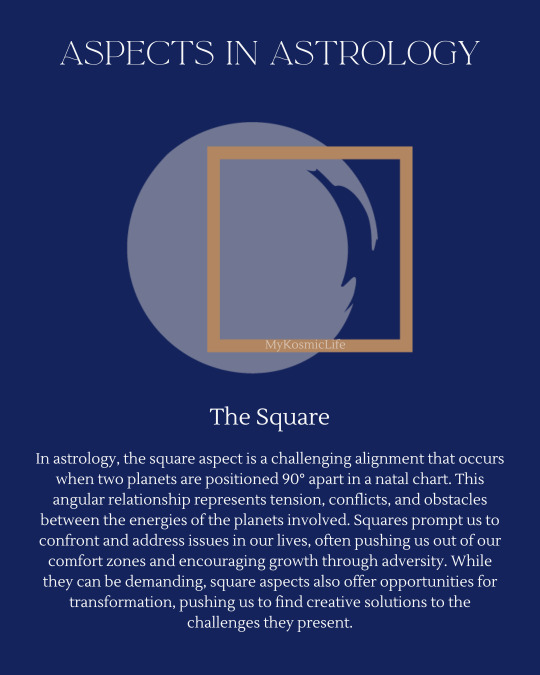

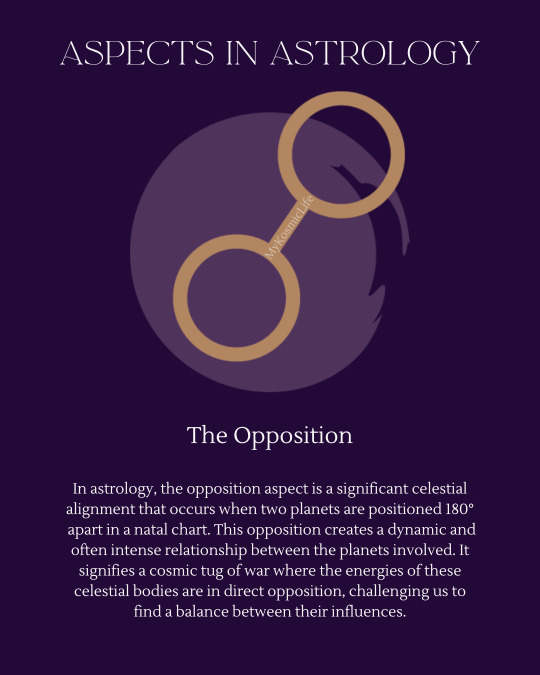
#square aspect#conjunction#Conjunction aspect#squares#sextile#Sextile aspect#trine#Trine aspect#oppositions#opposition#Opposition aspect#aspects in astrology#Aspects astrology#Major aspects#astrology aspects#sokosmic#mykosmiclife#astrology#astrologist#astro observations
80 notes
·
View notes